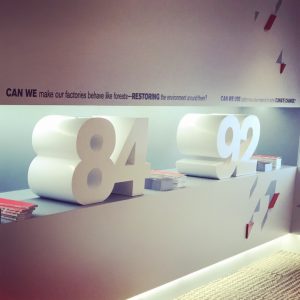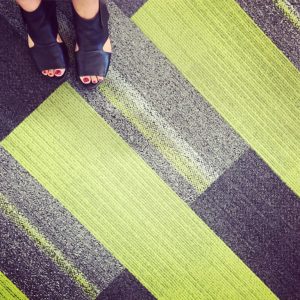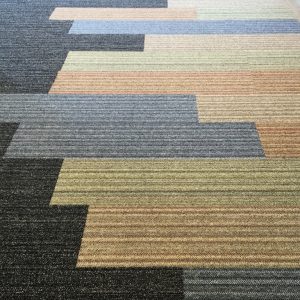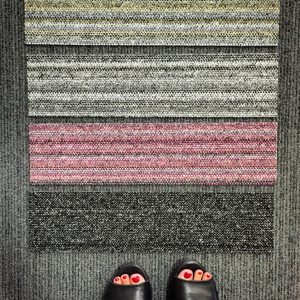A few months ago, I explored showroom after showroom in Chicago’s Merchandise Mart for NeoCon 2016, where each manufacturer brought out their latest material and product launches. Last month, I brought you the prevailing trends, but since the show’s end, I’ve been thinking about how all of these manufacturers and their products relate to the “generous brand” movement in retail.
As designers, if we are designing for generous brands and brands with a purpose, are our design decisions also in line with that philosophy? Do the choices we make, from the materials on the walls and floors to the materials that make up the fixtures and displays, communicate an authentic story that connects to the mission of the brand?
Photo: Courtesy of Rebekah L. Matheny, Columbus, Ohio
As I wrote in a previous blog, “Sustainable Storytelling,” retail owners express that 49 percent want to use more environmentally friendly products (McGraw Hill, 2013). But how much do we, the designers, really know about these environmentally friendly or “green” materials? Do we look beyond the surface marketing to the manufacturers’ “authentic” story? After all, manufacturers of interior finish materials are brands selling products, and we should hold them to the same standard as other retailers, expecting them to be generous brands and brands with a purpose, as well.
As I walked into one of the world’s largest modular carpet manufacturer’s showrooms, the space transparently told the story of its mission of being the most environmentally and socially sustainable company within the carpet industry. Since this manufactures conception, and every step along the way, they have redefined their process and product to align with that mission, evolving with technology and addressing the growing issues that endanger our planet and the people who occupy it. In the mid-’90s, the founder challenged the company to show the world what sustainability means to people, process, product, place and profits. From there, its 2020 Mission Zero project emerged. The goal is simple: to leave the world a better place than when they began; though simple in its statement, this is a very difficult challenge that has taken two decades to achieve, but achieve they did!
Photo: Courtesy of Rebekah L. Matheny, Columbus, Ohio
Advertisement
Proudly they state, “From something negative comes something positive.” This is a company dedicated to climate change, and its American manufacturing sites now uses 94-percent renewable energy, globally they use a total of 84 percent, dramatically reducing their carbon footprint by 92 percent since 1996. They challenge, “Can we design a supply chain that benefits all life?” In 2012, they did just that, establishing Net-Works, a program that addresses the negative impact of humans on the ocean by employing fishermen and divers in their off season to collect tons of discarded fishing nets. The company then gives those nets a beautiful second life as recycled nylon fibers in carpet tiles, while providing thousands of people (55,000 to be exact) in impoverished fishing communities around the world a more secure financial future. This proves that when business can innovate new products that impact the environment and people in a positive way, they can create collaborations that put boots on the ground to make social and environmental change. Just like many of the retails we’ve been discussing all year, this company is truly a generous brand!
This is just one example of what material manufacturers are striving to accomplish. There are many other examples, and I challenge all of you to dig deep each time you go to select and specify materials for your designs. Like we do with our retail purchases, investigate the material manufacturer’s total story!
As I tell my students, when we specify the materials that go into our built environments, we must go beyond just aesthetic and look at the material from a holistic lifecycle perspective. What does the material tell the customer from a visual and sensorial experience? What does the material communicate on the philosophical level? How can the materials reduce our impact on the environment?
This may be difficult, but if we are going to change the landscape of retail and create a better environment for future generations, we must challenge ourselves to think about everything that goes into the spaces we design.
Rebekah L. Matheny is the assistant professor of interior design at The Ohio State University (Columbus, Ohio), where she teaches courses in interior finish materials, lighting design and design studios that integrate a retail brand strategy process. Matheny’s research investigates the sensory perception of interior finish materials and their application in retail design to create an emotional connection between the customer and the brand. Follow Rebekah and her journey with materials on Instagram @rebekahmathenydesign and to start a dialogue about the Sensory experience of Materials visit her web site interiormaterialsmatter.com.
|
|
Don’t miss Rebekah’s International Retail Design Conference session, “Retail in Rio: An inspiring trip through the city’s retail scene,” Wednesday, Sept. 14, 9 a.m., where she and Rio de Janeiro-based architect Carolina Baltar will uncover emerging retail design trends in Brazil’s culturally rich metropolis. For more details about IRDC, Sept. 13-15, 2016, in Montreal, visit irdconline.com. |
Advertisement


 Photo Gallery3 days ago
Photo Gallery3 days ago
 Headlines1 week ago
Headlines1 week ago
 Sector Spotlight2 weeks ago
Sector Spotlight2 weeks ago
 Headlines1 week ago
Headlines1 week ago
 Headlines4 days ago
Headlines4 days ago
 Headlines2 weeks ago
Headlines2 weeks ago
 Designer Dozen1 week ago
Designer Dozen1 week ago
 Headlines2 days ago
Headlines2 days ago























